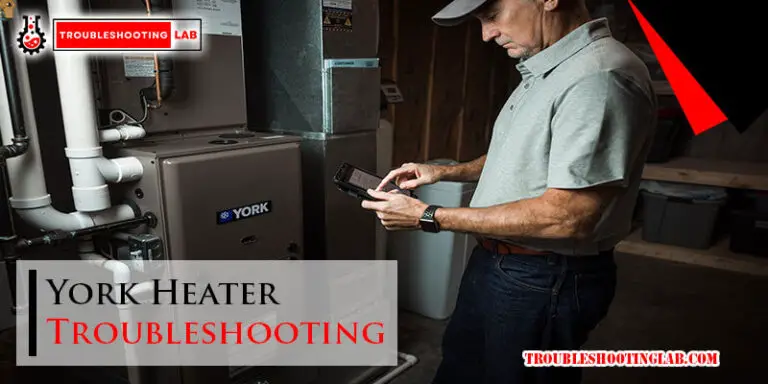Carrier Gas Heater Troubleshooting: Your Ultimate Guide
Is your Carrier gas heater acting up? Don’t worry, you’re not alone.
Many homeowners face issues with their gas heaters, especially during the colder months. Carrier gas heaters are known for their reliability, but even the best systems can encounter problems. From unexpected shutdowns to irregular heating, these issues can disrupt your comfort.
Understanding common problems and their solutions can save you time and money. This guide will help you troubleshoot your Carrier gas heater, ensuring your home stays warm and cozy. Whether you’re dealing with a pilot light problem or a thermostat issue, we’ve got you covered. Let’s dive into the most common troubleshooting tips to get your heater back on track.

Credit: hvacallianceexpert.com
Common Issues
Carrier gas heaters are reliable, but they can have issues. This section will explore common problems and how to fix them.
No Heat
If your Carrier gas heater is not producing heat, several issues could be the cause. First, check the thermostat settings. Ensure it is set to “heat” and the temperature is above room temperature.
- Pilot Light: If the pilot light is out, relight it following the manufacturer’s instructions.
- Gas Supply: Ensure the gas valve is open and the gas supply is on.
- Ignition System: Inspect the ignition system for any issues. Replace faulty parts if necessary.
Use this table to troubleshoot common causes and solutions:
| Issue | Possible Cause | Solution |
|---|---|---|
| No heat | Thermostat setting | Adjust thermostat |
| No heat | Pilot light out | Relight pilot |
| No heat | Gas supply issue | Check gas valve |
Intermittent Heating
Intermittent heating can be frustrating. Common causes include a dirty filter or faulty thermostat. Follow these steps to address the issue:
- Check and replace the air filter if dirty.
- Inspect the thermostat. Ensure it is functioning correctly.
- Examine the blower motor. Make sure it runs smoothly.
For intermittent heating, consider these potential solutions:
- Air Filter: Replace the air filter every 1-3 months.
- Thermostat: Replace or recalibrate the thermostat.
- Blower Motor: Lubricate or replace the blower motor if needed.
By following these steps, you can resolve most common issues with your Carrier gas heater.

Credit: hvacallianceexpert.com
Initial Checks
When your Carrier gas heater isn’t working, start with basic checks. These initial steps can save you time and hassle. Below are some areas to inspect first.
Power Supply
Ensure the heater is connected to a power source. A loose plug can cause issues. Check the circuit breaker as well. It might have tripped.
| Check | Action |
|---|---|
| Power Cord | Ensure it’s securely plugged in. |
| Circuit Breaker | Reset if tripped. |
Thermostat Settings
Incorrect thermostat settings can prevent the heater from working. Set the thermostat to a higher temperature.
Ensure the thermostat is in “heat” mode. Sometimes, it might be set to “cool” or “off.”
- Set thermostat to a higher temperature.
- Ensure it’s in “heat” mode.
- Check if the batteries need replacing.
If these checks don’t resolve the issue, you may need professional help. But first, make sure these basics are covered.
Thermocouple Problems
Carrier gas heaters are a popular choice for home heating. Sometimes, these heaters face issues that need troubleshooting. One common issue involves the thermocouple. A thermocouple is a safety device that shuts off gas if the pilot light goes out. Problems with the thermocouple can stop your heater from working. Here are some ways to identify and fix these problems.
Faulty Thermocouple
A faulty thermocouple can cause your heater to malfunction. Signs of a faulty thermocouple include the pilot light not staying lit. You may also notice that your heater does not produce heat. Dirt or a bad connection can cause these issues. Check if the thermocouple is dirty. Clean it with a fine sandpaper. Also, make sure the thermocouple is properly connected. A loose connection can lead to problems.
Replacing Thermocouple
If cleaning does not solve the problem, consider replacing the thermocouple. First, turn off the gas supply. Next, remove the access panel to reach the thermocouple. Unscrew the old thermocouple and disconnect it from the gas valve. Install the new thermocouple by screwing it into place. Reconnect it to the gas valve. Finally, turn on the gas supply and test the heater. The pilot light should stay lit, and the heater should work.

Credit: www.carrier.com
Pilot Light Issues
Carrier gas heaters are reliable and efficient. But, sometimes, the pilot light can cause issues. If your pilot light keeps going out, or you have trouble lighting it, you’re not alone. Many homeowners face these problems. This section will guide you through troubleshooting common pilot light issues.
Pilot Light Goes Out
If your pilot light goes out frequently, it can be frustrating. First, check for drafts. Strong winds or a drafty room can blow out the flame. You may need to block the draft or move the heater.
Next, inspect the thermocouple. This is a safety device that shuts off the gas if the pilot light goes out. A dirty or faulty thermocouple can cause problems. Clean it with a brush or replace it if needed.
Another reason could be low gas pressure. If you suspect this, contact your gas company. They can check and adjust the pressure for you.
Lighting The Pilot
Lighting the pilot light can seem tricky. Start by turning the gas valve to the “off” position. Wait a few minutes to let any gas dissipate. Then, turn the valve to “pilot.”
Press and hold the reset button. While holding it, use a lighter or match to ignite the pilot. Continue holding the button for about 30 seconds. This allows the thermocouple to warm up. Once the pilot stays lit, release the button.
If the pilot doesn’t light, there might be a blockage in the pilot orifice. Use a needle to clear any debris. Repeat the lighting process.
For persistent issues, it’s best to call a professional. They can diagnose and fix the problem safely and efficiently.
Ignition Control Issues
Experiencing issues with the ignition control of your Carrier gas heater can be frustrating. Ignition control problems are common and often prevent your heater from starting. Understanding how to troubleshoot these issues can save you time and money.
Ignition Failure
Ignition failure is a frequent problem in Carrier gas heaters. If the heater doesn’t ignite, check the power supply first. Ensure the thermostat is set to “heat” and the temperature is above room level. If the heater still doesn’t ignite, inspect the ignition system. Look for dirt or debris around the igniter and clean it if necessary. Also, check for any loose connections in the wiring. Tighten or replace any faulty wires.
Resetting Ignition Control
Sometimes, resetting the ignition control can solve the issue. Locate the reset button on the heater. Press and hold the reset button for 10-15 seconds. Release the button and wait for the heater to restart. If the heater fails to restart, check the pilot light. Ensure the pilot light is lit and steady. If the pilot light is out, relight it according to the manufacturer’s instructions. If these steps don’t work, the ignition control module may need replacement.
Gas Supply Problems
Troubleshooting your Carrier gas heater often involves checking the gas supply. Without a steady gas supply, your heater won’t function properly. Let’s explore two common issues: gas valve problems and gas line blockages.
Gas Valve Issues
The gas valve controls the flow of gas into the heater. If the valve is malfunctioning, it can prevent the heater from operating. Here are a few signs of gas valve issues:
- The heater won’t ignite.
- Intermittent heating.
- Unusual noises from the gas valve area.
To troubleshoot gas valve issues:
- Turn off the heater and gas supply.
- Inspect the valve for any signs of damage.
- Ensure the valve is in the correct position.
- Check for loose connections.
- Consult the manual for specific instructions.
If the gas valve is defective, you may need to replace it. Always follow safety guidelines and consider hiring a professional for repairs.
Gas Line Blockages
Blockages in the gas line can restrict the flow of gas to the heater. Common causes include debris, dirt, or pests. Signs of gas line blockages include:
- Weak or inconsistent flame.
- Burner won’t stay lit.
- Unusual smells near the gas line.
Steps to address gas line blockages:
- Turn off the gas supply.
- Inspect the gas line for visible obstructions.
- Use a soft brush to remove any debris.
- Check for kinks or bends in the gas line.
- Test the heater after clearing the blockage.
If the blockage persists, it might be deeper within the line. In this case, contacting a professional is advisable for safe and thorough cleaning.
Safety Switches
Safety switches are crucial components in your Carrier gas heater. They ensure safe operation by detecting issues and shutting down the system if necessary. Understanding how these switches work can help you troubleshoot and maintain your heater efficiently.
Flame Sensor
The flame sensor detects the presence of a flame in the burner assembly. If the sensor does not detect a flame, it will shut off the gas valve to prevent gas from accumulating. Common issues with the flame sensor include dirt buildup, corrosion, or a faulty sensor.
- Turn off the power to the heater.
- Locate the flame sensor near the burner.
- Gently remove the sensor for cleaning.
- Use fine-grit sandpaper to clean the sensor.
- Reinstall the sensor and restore power.
If cleaning does not solve the problem, replacing the flame sensor may be necessary. Always ensure the sensor is correctly positioned to detect the flame.
Limit Switch
The limit switch monitors the temperature inside the heater. It prevents overheating by turning off the burner if temperatures rise too high. A faulty limit switch can cause frequent shutdowns or the heater not turning on.
To troubleshoot the limit switch:
- Turn off the power to the heater.
- Locate the limit switch, usually near the heat exchanger.
- Check for visible damage or loose wires.
- Test the switch with a multimeter for continuity.
If the switch is faulty, replace it with a new one. Ensure the new switch matches the specifications of the old one.
By understanding and maintaining these safety switches, you can keep your Carrier gas heater running safely and efficiently.
Professional Help
Carrier gas heaters are complex machines. They need proper care and knowledge. Sometimes, issues go beyond basic troubleshooting. In such cases, professional help is vital. Knowing when to call a technician can save time and money.
When To Call A Technician
Strange noises from your heater signal a problem. Unusual odors may also indicate issues. If the heater does not turn on, call a technician. Frequent cycling on and off is another red flag. Inconsistent heating is a sign of malfunction. Any gas smell needs immediate professional attention. Never ignore these signs. Safety is a priority.
Choosing A Reliable Service
Research local companies. Read customer reviews. Look for certified technicians. Check their experience with Carrier heaters. Ask for recommendations from friends and family. Compare prices and services. Verify their licenses and insurance. Reliable service ensures your heater works efficiently. Your safety and comfort depend on it.
Frequently Asked Questions
How Do I Reset My Carrier Gas Heater?
Locate the reset button on the unit. Press and hold it for a few seconds.
Why Is My Carrier Gas Heater Not Igniting?
Check for a tripped circuit breaker or a faulty thermostat. Also, ensure the gas supply is on.
What Should I Do If My Heater Is Blowing Cold Air?
Ensure the thermostat is set to “heat. ” Check the air filter and clean or replace it if needed.
Why Does My Gas Heater Keep Turning Off?
This could be due to a dirty air filter, overheating, or a malfunctioning thermostat. Inspect these parts.
How Can I Improve My Gas Heater’s Efficiency?
Regularly clean or replace filters. Schedule annual maintenance. Ensure vents are not blocked.
Conclusion
Troubleshooting your Carrier gas heater doesn’t have to be hard. Follow the simple steps outlined in this guide. Keep your heater clean and check for common issues. Regular maintenance prevents many problems. If issues persist, consider professional help. Ensuring your heater runs smoothly keeps your home warm.
Always prioritize safety when working with gas heaters. Stay warm and cozy with a well-functioning heater. Happy troubleshooting!






